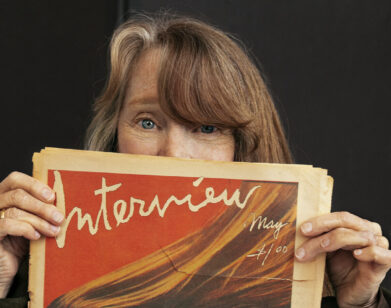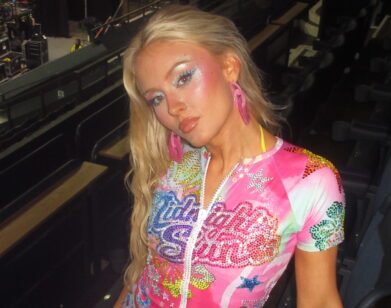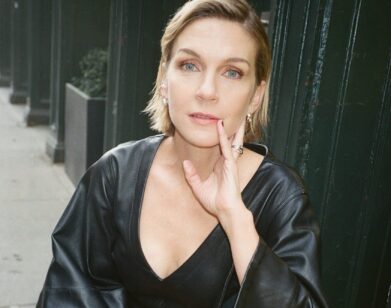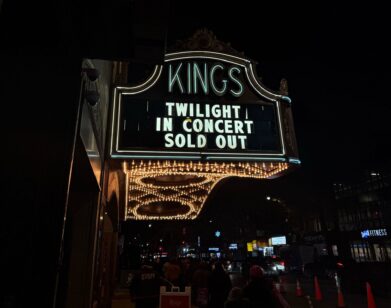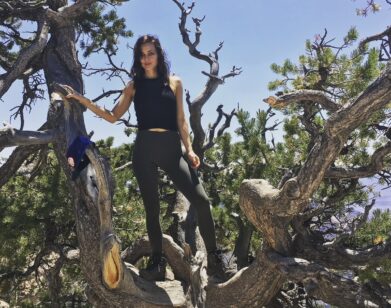@Kevin
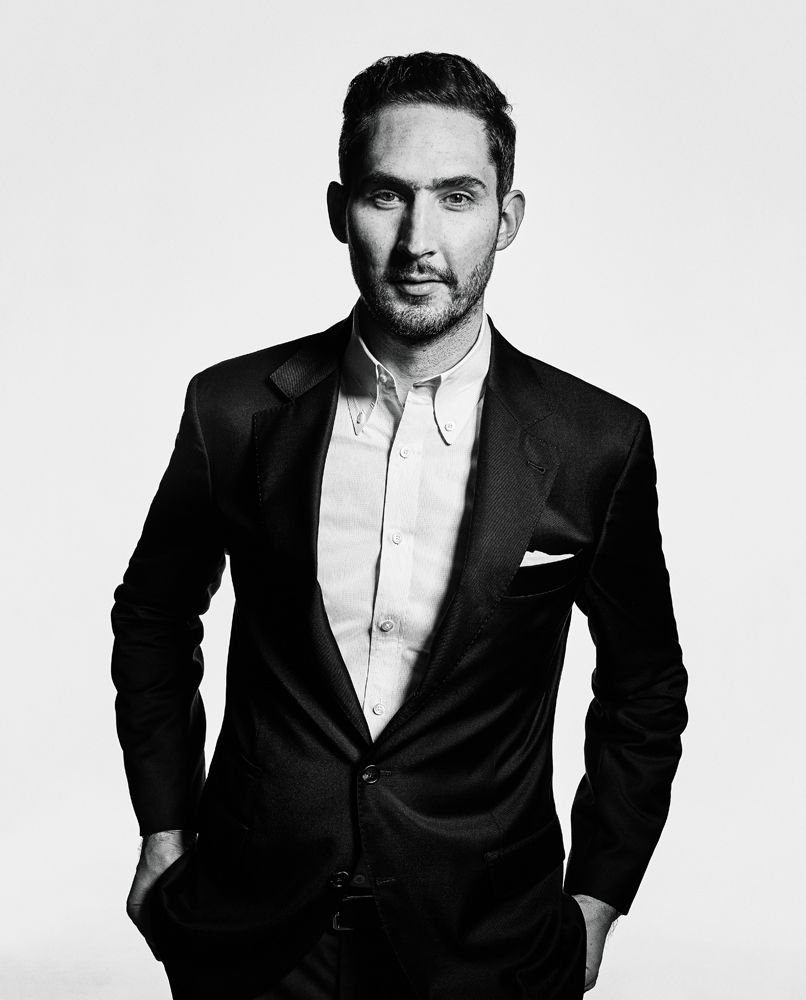
KEVIN SYSTROM IN NEW YORK, JUNE 2015. ALL CLOTHING: SYSTROM’S OWN. SITTINGS EDITOR: MIGUEL ENAMORADO. GROOMING: SARAH SIBIA FOR SEE MANAGEMENT. SPECIAL THANKS: INDUSTRIA SUPERSTUDIO.
In one of their characteristically loose and freewheeling conversations for this magazine not long after Ronald Reagan was first inaugurated, Mick Jagger and Andy Warhol got to riffing about nothing and everything over champagne and tea at Jagger’s Central Park West apartment. So overwhelming was the barrage of media then vying for their attention that summer, that it seemed, Jagger said, “Everyone could get their own TV show on cable … their own TV show on their own channel.” That was in 1981.
Well, it’s the future now, and Andy too was right. Everyone is, if not exactly world famous as he predicted, at least broadcasting. We are all the directors and willing stars of The Truman Show about ourselvesâ??or at least versions of them. I happen to believe that, as with dreams and memories, our projections of self needn’t be real to be right. In fact, it is their diversions from objective truth that make them interesting. The alterations to and even wholesale creation of images are what remain in our ever-changing palimpsest of identity. Our phantom memories, like fantasies and nightmares, are marrow-deep projections of our values, our aspirations, our fears. They are the realest rendition of who we were. That, and what we post for #tbt.
In that way, the entries onto our various timelines may be more autobiographical than any strictly historical lifeline. They illuminate patterns of thought and self-image in real time, tracking us through our arcs of interest, infatuation, and correction like our browsers do (and with as many select-all-deletes) to make a collage of our various selves. Consciously or not, our posts show us as we are, by showing us as we’d like to be at the moment. Fake it till you make it, I say; you are what you tweet.
And increasingly I’m beginning to wonder if that is all that we are. Like a world of wizards in our present hyper-reality Oz, there doesn’t seem to be, behind the avatar, some essential, ultimate us. As our devices and their various platforms become more articulate, we can be more specific in our projections, certainly, like going from picking a Street Fighter character to fight with to Ex Machina-ing our perfect digital self. But there is no Platonic form of Chris Wallace behind the veil of my various feeds, in other words, just different, equally lost and thirsty Chrises IRL. If anything, my Twitter voice and Instagram feed are reductions of just a single facet, one character in the clusterfuck chorus in my head-less changeable, evenâ??a single character on Key & Peele repping the entire show.
And in the court of public opinion, the evidence we present is all that matters. If you don’t Instagram this sunset, it never happenedâ??ditto your workout, beach vacay, visit to the 9/11 memorial, or perfectly symmetrical pile of food. And beware which pile of food you shoot, because it is better to get likes than to be lovedâ??JK! Wanting to be loved is what this whole dance is about. Or to get work or dates or friends or affirmation, which is saying the same thing. And if we have to expose ourselves to judgment (or just expose ourselves) in order to do it, we’re more than willing to risk itâ??even as we knowingly occupy the same space with artistic geniuses, globeÂtrotting Kens and Barbies of unparalleled beauty and bodily perfection, and personalities we’d pay to see on any other screen. Wading in to all of that to post anything these days can feel like taking a stage to pick up the mic Dave Chappelle just dropped.
But we’re not so vain as to think this piece is about us; we are in this together, like the jewels in Indra’s net reflecting every other jewel in the universe.
Because, no matter how cool or disaffected we can be, the way we are seen, received, and responded to by the world around us is a gigantic piece of the way we see and conceive of ourselves. And now, in a way hitherto impossible, we can control that, at least in part. Blogs and Twitter gave everyoneâ??almost everyoneâ??a voice. Facebook, YouTube, and now, overwhelmingly, Instagram have given each of us our own OWN network. It may not have the ratings of Oprah’s channel, but it is there, we are there. Might as well shine bright.Â
No one in the interconnected now has been more instrumental in laying out this bejeweled net than the mayor of our sim city, Kevin Systrom, co-founder and CEO of Instagram. Born in Massachusetts in 1983, Systrom grew into the kind of person we call a tinkerer, and what he describes as obsessive. At boarding school, he worked at a record store, DJ’ed, wrote programs, and started a pirate radio stationâ??like everyone does. During a study abroad year in Florence, Systrom fell deeper in love with photography and the famously mealy square pictures produced by a Holga camera. And, after graduating from Stanford in 2006, he worked for a while at Google before creating the check-in app Burbn and then, in 2010, launching, with his partner Mike Krieger, the world-dominating visual media platform that I’m trying not to look at right now.
In 2012, Facebook bought Instagram for a you-know-what’s-cool billion dollars, reportedly netting Systrom something in the area of $400M. Appropriately, accolades and famous friendships have followed: In presenting Instagram with the 2015 CFDA Media Award, Systrom’s friend Kim Kardashian West said of his creation, it is “where the creative dialogue begins.”
But that’s all in the CEO bio, the legend, as it were. When I caught him on the phone at his office in Menlo Park, I wanted to talk to Systrom about the difference between Kevin and @kevin, if there is one, about the way Instagram is changing us and vice versa. And to complain to him about my habits.
CHRIS WALLACE: Don’t take this the wrong way, but you’ve ruined my life. [Systrom laughs] And I’m not the only one. I’ve been talking to people about our severe addictions to Instagram and the way that it’s changed our interaction with the world. But what’s you own personal usage like? Are you as crazily and cravenly addicted as the rest of us are?
KEVIN SYSTROM: I am. I have the funny situation of being the first user and the longest tenured userâ??I guess those are the same. What I found is, this was not true at the beginning, but there’s this never-ending stream of stuff to discover. I have this strange obsession for following golden retriever accounts. I have this 2-year-old golden retriever named Dolly who has her own account. And the number of other golden retriever owners you can connect with in the world is pretty astounding. We like to say if it’s happening in the world, it’s on Instagram. And that wasn’t true five years ago. Five years ago it was a place for photographers to connect and share on their iPhones the stuff that they were doing out in the real world and make a hobby of it. But it’s so broadly applicable to each and every man, woman, and child that it means people are capturing their interests, no matter how niche, no matter how off-the-wall. You can follow people who do latte art in Tokyo; you can follow basket weavers in Aspen; you can follow sushi chefs from around the world. My own personal behavior is that I open these windows into things. I’m getting married in October [to longtime girlfriend Nicole Schuetz]and I started following all these floral arrangers, because I followed the person doing our wedding, and then it started suggesting others, and I was like, “Man, this is super cool.” I find myself getting lost in certain categories. I’ll get bored with one category and unfollow those accounts and move onto the next one. My own personal behavior is a little scattershot, but I’d say 90 percent of my time and effort and thinking is going into, “How do we run the company that makes all of that possible?”
WALLACE: It is incredibly reflective of, as you say, these niche communities, which I particularly loveâ??little corners for obsessives of every stripe. I wonder, too, how we are changing our behavior to fit into the frame of Instagram, how the mirror looks back at us. How is it affecting the way we see the world, see others, see ourselves? Having it all right there in the palm of our hand, this seemingly intimate interaction.
SYSTROM: On the intimate relationships, I’d say you can be someone who wouldn’t normally get attention in traditional media and come onto Instagram and build this massive following. Or you can be a couple in London who happen to take pictures of their breakfasts every dayâ??it’s called @symmetrybreakfastâ??and you can gain hundreds of thousands of followers overnight because people are genuinely interested in your unique angle on the world. There’s this intimacy with their lives and their passions and their interests that you get through Instagram that you would never get through, frankly, any other platform. Definitely not traditional media. And it’s not a one-way street; it’s not just a broadcast platform. There’s a chance to actually connect with people and form relationships. The number of people who have either gotten married or had kids or started dating or just made great friends over Instagram is countless. I think we’re the only platform that continues to be successful in bringing people together in real life for these real relationships. And I think it’s a testament to the quality of community on Instagram. Everyone is very open and intimate and vulnerable with their lives. From the really moving accounts to some more superficial accounts, like Marnie the Dog. And by superficial, I mean hilariously funny and engaging.
WALLACE: The democratic-accessibility aspect is really interesting to me, in that it gives voiceâ??or really, imageâ??to people who might not otherwise get to broadcast their own image. I’m not sure if I have a read about how that’s affecting our understanding of one another and how we communicate with one another, but I do think that it is. I can feel it playing with my own tastes, with the way I see the world, and, I’m embarrassed to say, see myself.
SYSTROM: Well, the challenge with traditional media is it’s one-size-fits-all. So you have to appeal to this median voter; there’s this median-voter theory, where the most efficient way of getting electedâ??not the right way, necessarilyâ??is to appeal to the median voter. Median tastes, median positions on issues. I think typical mass media has to appeal to the median voter. And what’s awesome about social media is you curate your own experience. That leads to the rise of niche celebrities, who are actually just as popular as mass celebrities, but because there’s no incentive for traditional media to invest in them as celebrities, they find a home where people can follow them on Instagram. Say I’m really into espresso or kite surfing; I can really dive into that on Instagram. The second result of being able to curate your own experience is around aesthetics. I actually think we challenge the notion that beauty comes in a traditional, artsy form. A lot of the earliest Instagram celebrities took really beautiful photos. But you’re starting to see a change where it’s not about beauty; it’s about the story that you tell. Yesterday I had this really awesome opportunity to meet Katie Meyler, who was one of Time magazine’s Persons of the Year last year. She was in Liberia during the Ebola crisis, and she basically documented the entire experience on Instagram. I would not claim that each and every one of her photos is artistic, in the sense that you’d hang it on your wall; it’s more photojournalistic. But she was telling a story. And there was no single frame that did that; it was the collection of her story. It challenges the notion that photography has to be about beauty. It can be beauty in story and soul and spirit and humanity, rather than simply visual aesthetics.
WALLACE: Well, that’s the personal touch that throws off whatever ideas we have about what “works” on Instagram. But what do you think makes for a successful single post or collective presence on Instagram?
SYSTROM: I always look toward teens on Instagram to really understand what’s going on. For some reason, when you’re a teen, you just understand the world better than anyone else. We, as adults, think teens don’t understand it, but, man, when you sit down and talk to teens about how they use Instagram, one of the things you’ll hear is that they have a look. You’re supposed to maintain a “look” on your profile, a consistency. That can be both visual and stylistic. Like they use a single filter over and over again. Or it can be a type of story or a type of content. I mean, I just take random pictures. Part of that is because I just like taking random pictures. But the most accessible accounts typically have a theme. And if you go onto teen accounts, they will manage their profiles such that they have a consistent theme of content and/or aesthetic. And I think if you look at the most popular accounts, even of the celebrities out there, they generally do too. Kim Kardashian’s account, one of the most followed accounts, is very themed. A consistent variation on a single theme. You’re really producing a channel. And if you have a consistent experience on that channel, people end up loving having new updates to that channel over time. It’s when it’s random that it becomes harder. So, I’m thinking, “What is my theme? How do I present this?” I have a pretty random life. I run a business and go all over the world doing things for that business, things that are fairly orthogonal. But my job is to run my company, not to be the best Instagrammer. I’ll let other people be awesome at it.
WALLACE: It’s funny, though, because it does place those demands on you. It does place that demand that you make choices when you’re posting about how you are presenting your life. You must be thinking, at least peripherally, about the “Kevin” that you are projecting.
SYSTROM: As an experiment last weekend … Teens have this notion called a “finsta” account. Again, teens just understand the world in ways I don’t think any of us adults do. So they have the regular account, and then they have a quote-unquote “fake” Instagram account: finsta account. And on the finsta account they’re not chained down in any way to any look or theme; they literally overshare every day each and every thing that’s happening in their lives. The volume at which they post is much higher, and they worry less about aesthetics. Whereas their real Instagram account is the best presentation of themselves. I decided this past weekend that I’m going to do this for one week. So I created a finsta account, and I’ve just been sharing privatelyâ??I think I have seven followers on the accountâ??a bunch of random stuff, throughout my workday. If I’m on this call, I’ll take a selfie. At my next lunch meeting, I’ll take a picture of my lunch. And as I’m just sitting in these different experiences, I’m asking myself, “Why do they exist? Why do people feel the need to create these other accounts?” It’s really fun for me, because I’m in a position where I try to create the system where behavior emerges. And sometimes behavior emerges that I don’t quite understand. And it’s interesting to see young people really take on this dynamic of this duality. Both the branded account and then the really vulnerable, open account. What I found, actually, is I ended up posting things on my own @kevin account from the finsta account because I’m like, “You know what? These are actually pretty good photos, and I wouldn’t mind sharing those with the world.”
WALLACE: I think I’m doing it backwardsâ??I am the finsta version of the me I want to be. But, related to this, and befitting the magazine that Andy Warhol built, I think a lot about the self we make public, how it is different from our private self. I talked to a lot of very public personalities about that divide for this issue, and all of them said that Instagram is their point of entry for that, the expression of their public selves, almost a canvas for that art form.
SYSTROM: Right. People have presences, both online and in real life. You can choose to show everything, meaning all sides of you, or you can choose to be selective. I think Instagram at its best is where you feel like you’re getting the most authentic version of the person on the other side of the camera. Someone who does this wonderfully well is Lena Dunham. She’s obviously a celebrity in her own right, but she’s posting stuff like photos from bed, reading a book, when her dog is sickâ??she’s bringing you along. And perhaps that’s what makes her so special, and why she’s so famous, because everyone can relate to that person who has these problems in real life. That’s Instagram at its best. When it becomes about curation and a veneer, it’s not nearly as authentic. I think the worst version of this is when celebrities have their teams take over their accounts. They don’t manage it, and it becomes upkeep. What we’ve seen is that when people show their real selvesâ??what they’re dealing with every day, what they’re thinking aboutâ??it’s actually when they get the most engagement. I guess you could say even that is maintaining an avatar, a personality, but I think Instagram at its best is that authentic world. I was on a panel with the artist Amalia Ulman at Art Basel Miami Beach last year, talking about her experiment where she did a play on her account. So it was her, she told this story about herself, about her experience, but she was playing a character the entire time. It was this whole ruse on her followers, trying to gain followers and to tell a completely different story as a character. [Curator and critic] Hans Ulrich Obrist was on the panel, and we were all talking about how that’s a new art form, character playing on Instagram, creating these avatars that aren’t yourself to tell a story and bring people along. I thought that was pretty cool.
WALLACE: To an extent, we do that in our real lives as well, to find ourselves, find out what we like, maybe even with the goal of some sort of authenticity, when the divide between the public self and the private self dissolves as much as possible. It’s like finding a voice as a writer, the clarity of self-expression. Do you do that well? Do you feel like the Kevin that exists as @kevin approaches Kevin in real life?
SYSTROM: Yeah. I think this is an important and timely question, because now that I’ve started using this finsta account, I realized, “Wow, I really do hold back a lot of things that I would post normally.” Obviously, being the CEO, there are a lot of eyes on what you do and what you post and how you post, and I think one of the challenges of Instagram in general is that, as we get bigger, there are just more voices in the room, more eyes on everyone’s accounts. Some people react really positively to that and share more. Othersâ??I’m a fairly private person myselfâ??react in a more constrained manner. I think what this experience has taught me is there’s real beauty in pushing yourself to expose the real you in more ways. I could share stock photos of me in staff meetings, you know? But what’s kind of cool is Instagram provides a vehicle to have that struggle publicly. Which is, like, telling more about yourself if you’re a public figure. Showing more of yourself to the world and challenging yourself to be more open.
WALLACE: How would you like to be seen?
SYSTROM: Well, keep in mind that Instagram didn’t exist five years ago. This was basically two guys in a garage five years ago thinking, “Hey, maybe we’ll start a photo-sharing app.” And the meteoric rise and ubiquity of the platform has been surprising to a lot of people, including ourselves, and I think what we have navigated as a team over time, and what I have as the co-founder, is how people see you and your interactions on the platform over time. What I’ve learned is that people really appreciate hearing about the real you. I post a bunch from fashion events, because I’m really into fashion; it’s one of my personal passions. It’s been a really wonderful discovery about myself. That’s what I love posting on Instagram the mostâ??when we get dressed up and choices of what we wear. And that’s kind of antithetical to most tech founders. But I love that tension. I love challenging the notion that, in order to be a tech founder, you have to be holed up in a dark room wearing a T-shirt and baggy jeans. I really appreciate crafts. I like cooking. I love food and drink. I love owning that through Instagram. Although that can be challenging at times because it doesn’t fit people’s stereotypes of a technical founder.
WALLACE: Were the seeds for this you always there? Part of this mythos about you is that when you were a kid, you would rewrite the video games you would play and add to them. Were you always a tinkerer? Were you trying to rebuild the world?
SYSTROM: Two things to know: one is I’m not purely scientific, mathematic, if that’s a word. Where I love to be is at the intersection of science and art. I was never as focused in math, science, computer science, etcetera, as the people who were best at it. I wanted to create amazing screensavers that did beautiful visualizations of music. It’s like, “Oh, I have to learn computer science to do that.” A means to an end, not an end itself. And I really love connecting people, creating communities. As a kid, creation was something that I always loved. Creating worlds for video games, creating businesses that didn’t make any money, selling lemonade, etcetera. In my fourth grade classroom, I even instituted a government structure, because I was really interested in people having positions and there being law. In high school I bought a giant antenna with some of the money that someone had donated to the school to start a radio station. I hung the giant antenna outside my dorm roomâ??I went to boarding schoolâ??and started, I guess it was a pirate radio station, since I don’t think I had a license at the time.
WALLACE: How do you deal with the tension of having created this thing, which is mind boggling in its success, with wanting to go create the next thing?
SYSTROM: I mean this in the nicest way, but the fallacy in the question is you can’t do new things within Instagram. I agree that you’re not going to be able to create another company. But actually having a company that’s successful is a wonderful platform to do new things. You don’t have to raise money for it; you can take profits from the company and pump them into new business. You can fail and restart and still have your core business. And that’s been a fun realization for all of us here; that we can spend 80 percent of our time on the evolution of Instagram as it is and 20 percent of our time, or more, on new ideas. Whether those are small apps or Hyperlapse, which is next-generation stabilization technology for time-lapse video. And then there are other verticals, like, we set our sights on working in the world of fashion. We want to feel at home in these places and understand them. We love our community.
For more #InterviewGang, click here.
Â

